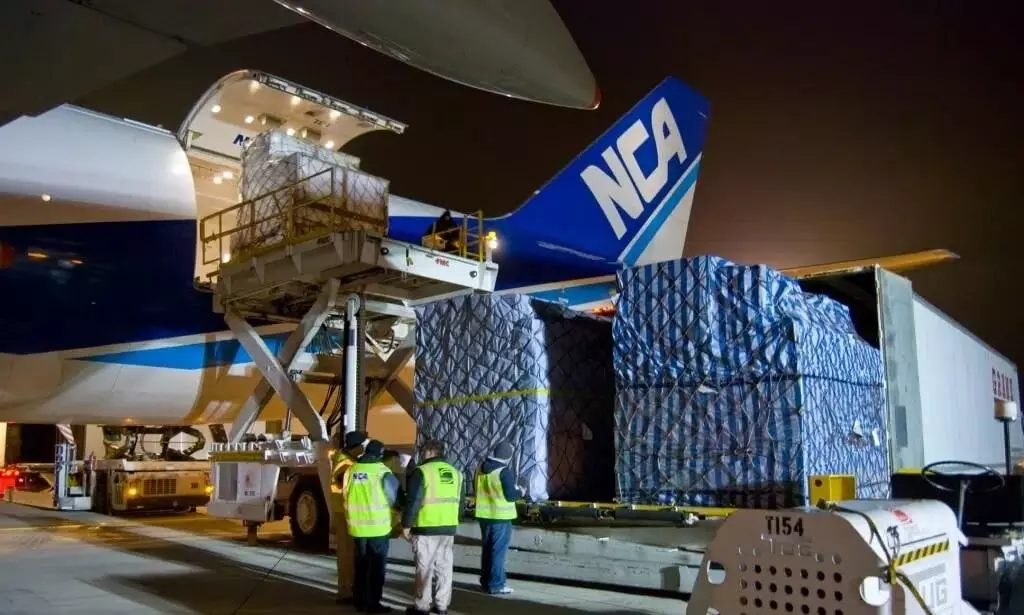
Cargo-focused airports in U.S. outperform others: Study
Traffic at 16 cargo-focused airports in U.S. declined 3.4% YoY during 12 months ending April

Cargo operations at Chicago Rockford International Airport
Traffic at 16 cargo-focused airports in the U.S. declined only 3.4 percent during the 12 months ending April compared to the same period last year, less than half of the 8.9 percent drop at the 16 largest cargo handling airports that have extensive passenger traffic. Traffic at U.S. airports, on the whole, dropped even more, by 9.1 percent.
"The ability of these airports to provide users with extensive operational flexibility, land for warehouse development and maintenance facilities, and lower fees appears to underlie their recent success," says the latest report from the Chaddick Institute co-authored by Professor and Director Joseph P. Schwieterman and Research Associate Janson Busby.
The strongest performers include California’s San Bernardino International (up 11.4 percent), Ohio’s Wilmington Air Park (up 4.6 percent), and Florida’s Lakeland-Linder Airport (up five percent). Five of the 16 cargo-focused airports experienced traffic gains, and 10 outperformed the national average.
"We define cargo-focused airports as those handling: 1) at least 20 million pounds (9.07 tonnes) of domestic air cargo annually; and 2) fewer than 320,000 passengers in 2022. Those outside these thresholds rank well outside the top 125 airports in the above categories," says the authors Schwieterman and Busby.
Eleven cargo-focused airports now rank in the top 100 in traffic, up from nine in 2019, and two now rank in the top 20, up from just one – Chicago/Rockford – in 2019, says the report. "Nine of the 16 rose in rank over the past year and only four fell. Chicago/Rockford rose from 17th to 14th, and San Bernardino rose from 33rd to 28th after ranking 85th in 2019. Lakeland-Linder rose from 40th to 36th, after having no reported 2019 traffic. Wilmington rose from 25th to 24th after being 70th in 2019, and Fort Worth Alliance remained 18th."
Over the past year, Amazon Air hubs, statistically, outperformed integrator hubs while integrator hubs outperformed non-cargo-hub airports, the report added. "Although Amazon Air may have accounted for only a small share of cargo, its countercyclical growth and its recent focus on its largest hubs helped offset cutbacks by other carriers."
Since 2019, traffic at the 16 cargo-focused airports has grown by 53.6 percent compared to 2.4 percent at the 16 largest mixed-purpose airports and 12.2 percent at all U.S. airports. "So, cargo-focused airports are enjoying post-pandemic success."
Obstacles facing cargo-focused airports
"Among the challenges facing cargo-oriented airports is an inability to exploit the complementarities of freight and passenger traffic in airport facility planning. Cargo-oriented airports that lack passenger flights are also less able to cross-utilise runways, taxiways, and air-traffic control systems. The tendency for cargo- and passenger-oriented flights to operate at different times can result in efficiencies at airports with a significant volume of both types.
"The operation of freighters is often concentrated during nighttime and early morning hours when passenger traffic is usually light or nonexistent. Airports with extensive nighttime and daytime flight activity can spread their fixed costs over a more extensive base of traffic, which can help justify large-scale capital improvements. UPS’s massive Worldport facility at Louisville’s international airport exemplifies how cargo and passenger facilities can extensively cross-utilize fixed assets.
"Cargo-oriented airports also provide prospective shippers with less (or no) opportunity to transport freight in the belly compartments of larger passenger aircraft, which is often a relatively inexpensive shipping option. In addition, using belly space provides ancillary revenue for passenger-focused airlines, which can strengthen the performance of passenger operations."
Factors benefitting cargo-focused airports
While passenger airlines may develop networks that make the total duration of the trip as short as possible and provide customers with many schedule options, cargo airlines may be motivated by a desire to guarantee that cargo arrives by a specific delivery time (such as by the morning of the next day), the report added.
"The market for air cargo is less sensitive to additional mileage travelled than passenger traffic, making it feasible to locate air cargo hubs farther away from major cities where road congestion is less severe. The reduced congestion lessens the risk that ground transportation providers will miss “cutoff times” for the delivery and transfer of cargo to airlines and other freight forwarders."
The success of large cargo-focused airports suggest that these specialised facilities are poised to continue rising in prominence, and although only two rank in the top 20 in cargo traffic, most are rising, with eleven now in the top 100, up from nine in 2019, says the report. "The findings show that cargo-focused airports have recently outperformed other U.S. airports, indicating they are worth additional consideration among policymakers and transportation providers."

